Shravan
” श्रावण मासी हर्ष मानसी हिरवळ दाटे चोहिकडे,
क्षंणात येते सर सर शिरवे क्षंणात फिरुनि ऊन पडे”
“Shravan” is the 5th month in the Hindu calendar, the second month of rainy season.
Heavy rains and budding flowers are the companion of this month, this year the “Jai” flower creeper in our garden is flourishing with flowers.
Shravan has many festivals most of which are based around poojas, adjusting to the changes in the weather through consuming minimal and healthier food, celebrating the importance of animals which help in harvesting and celebrating monsoon.
First festival in Shravan at home is NaagPanchami (नागपंचमी) :
Heavy rains cause the snakes to come out of their holes . They are a boon to the farmers since they keep the rodents off the farms. My personal take is that this festival is celebrated to pay respect to this magnificent creature which helps the farmer to retain a good harvest. On this day no sharp metal objects like knives, ploughs, axes etc. are used. Hence dishes prepared today are only by steaming method. It’s also good for the tummy as the monsoon weather reduces the digestion power.
Every year I prepare a traditional dish called दिंड (Dinda) on this day. It is a heirloom recipe handed down to me by my mother-in-law. दिंड are made from wheat flour as outer covering and chana dal based puran as the inner filling.
To prepare puran, soak the chana dal in water and then boil till it becomes soft. Grind in the puranmaker, add jaggery, a pinch of salt, cardamom and nutmeg powder per taste. Don’t forget to check the consistency of puran with the standing spoon test (basically it should be thick enough for a spoon to stand without any support).
Once the puran is done let it cool. Now start with the dough for outer covering. It has to be made by adding a bit of warm oil (मोहन ) and mixed to form a dough using minimal water. The resulting dough should be stiff enough to hold the puran and not allow it to ooze out but not very dry too. Add a little bit of thin rava (semolina) for a nice texture.
Roll out a small round , size of around 3 inches. Now place a spoonful of puran in it and fold the round in the form of a small square packet. Ensure the puran fills up the packet. Stick the ends of the packet by applying a touch of water while folding. Once done, steam them in a idli maker/ perforated dish for 10-15 min on a medium flame till they get a shiny look. दिंड are ready to be served piping hot with a good dollop of homemade ghee.
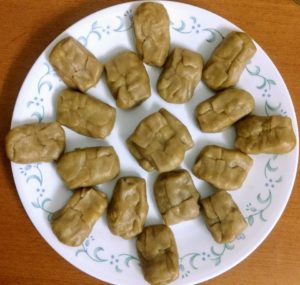
Shravani Somwar (श्रावणी सोमवार):
Each Monday of Shravan is devoted to worship of Lord Shiva. Normally both men and women observe fast to please Lord Shiva. Sola Somwar vrat (16 Mondays Pooja) also begins on the first Monday of Shravan .
On this day, the married women in every Maharashtrian household perform a pooja of Lord Shiva wherein shiva mooth (शिवामूठ) of four different offerings are offered to Lord Shiva (Rice, Til, Green Moong and Javas).
My personal take on this is that Rice and Green Moong are easier to digest , contain good amount of carbohydrates and protein. Til (Sesame Seeds) and Javas (Flaxseeds) are high on nutrients. Hence, by offering these to Lord Shiva, indirectly our forefathers were sharing with us the kind of food to be consumed during fasting which is simple yet nutritious.
Find some good Til and Javas Chutney recipes below:
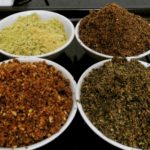
Mangalagauri Pooja (मंगळागौर):
Tuesdays in Shravan are for Mangalagauri Pooja.
On this day, pooja are performed devoted to Goddess Gauri . Women dress up in traditional wear (nine yards saree) to perform this pooja. Women perform this pooja to seek the blessings of Goddess Gauri for the well being of their husbands and for a happy married life together.
Beautiful Rangolis are drawn by the women with the pooja area decorated. The newly married girls give 16 ladoos to their sister-in-law/s and mother-in-law. After this, the group of married ladies light up 16 lamps to perform aarti in front of the Goddess. On the next day of the idol of the Goddess Gauri is immersed in a pond. Normally this pooja is done for first 5 consecutive years of the marriage.
On this day after the pooja all the women play games with witty songs expressing their newly married life experiences. They continue these games through the night.
My personal take is that this pooja gives the newly wedded girl to visit her families and share her new home experiences with her mother and friends. The games played are an awesome way to exercise indoors when it’s raining heavily outside.
Mostly the food items eaten on this day are Matki usal, Masale bhaat, Bhajani vade, curds etc.
Shravani Shukravar (श्रावणी शुक्रवार):
This pooja is mainly devoted to Goddess Varalaxmi.
In Maharashtrian household we perform the Jivati Pooja (जिवती पूजा) on every Shravan Friday. This pooja is performed by married women who have kids for their good health, happiness and well-being. There is a tradition to invite a married woman with kids for lunch on this day. The menu includes puranpoli and other Maharashtrian food items to go with it.
Married women are also invited at home for Haldi Kumkum ceremony and given roasted grams as prasad.
Check out a tasty roasted gram recipe here
On this day I normally make puran or puranpolis for naivedya (offering to God).
Sheetala Saptami (शीतला सप्तमी):
For this day, food is cooked one day prior and then next day it is eaten. It is also said that Goddess Sheetala is worshiped on this day . No fresh food is cooked on this day, an official break from cooking.
Normally previous day bhakri (Jowar/Nachni/Rice) is eaten with milk/curd on this day. The bhakri and the curds containing good bacteria add to the making the gut healthy. This also helps get rid from bloating or acidity. What a good way to preserve gut health when the outside weather is humid and digestive power is low.
Narali Pournima (नारळी पौर्णिमा):
On this occasion, a naral (coconut) is offered to the Sea mostly by the fisherman community. It is believed that by performing the pooja on Pournima, they can please the sea and seek protection from all dangers of the sea.
Basically this day denotes the beginning of the new fishing season. Singing and dancing are the main attraction of the festival.
We prepare Narali Bhaat or Sweet coconut rice using Jaggery, Basmati Rice and spices like Cardamon, Cloves etc.
I also make Olya Naralachya Karanjya and Thai Curries on this day since its all about the coconut. Why Coconut? Well, coastal region has lot of coconut trees and common sense says its the best offering available for this festival during this time of the season.
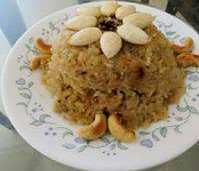
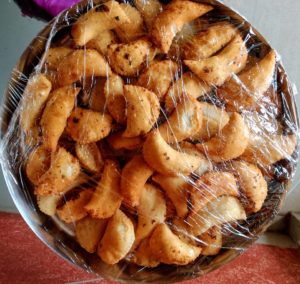
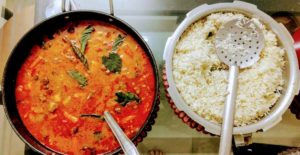
Rakhi Pournima (Same day as Narali Pournima) (रक्षाबंधन):
Rakhi is tied on the brother’s arm by the sister and she prays for his well-being while he promises to always protect her. This bond does not have to be between blood relatives. This ritual strengthens the bond of love and also transcends the boundaries of the family.
The best part for me about Rakhi Pournima is watching the small kiddos around showing off the number of rakhis they have on their hands. For me memories of my brother and me as kids celebrating this festival are most cherished ones.
GokulAshtami (Krishna Janmashtami) (गोकुळाष्टमी) :
This festival celebrates the birth of Lord Krishna. Dahi Handi is celebrated the day after Krishna Janmashtami.
It is said that baby Krishna used to steal butter and yogurt when his mother used to make it. So she tied the pot containing butter and yogurt high and hang it from the ceiling so that he could not steal it all the time. But Krishna, along with his friends used to build a human pyramids and reach the butter pot to eat.
In my maternal home society, till today, we have a small Dahi Handi celebration. It is different for adults and kids wherein all of us participate with our friends to get the pot down. We also tie other gifts and fruits like bananas to the rope which then get distributed to the kids who form the pyramid that breaks the handi. After the handi is broken, everyone gets a prasad made from the dahi and pohe.
I make the prasad using Dahi, milk, pohe, Saalichya lahya and banana for the home pooja.
Satyanarayan Pooja (श्री सत्यनारायण पूजा):
This is one pooja that is done mostly in all Maharashtrian homes during Shravan. The pooja is done by the main married lady and her husband who fast during the day. The Satyanarayan vrat kathas read during the pooja help one to realize the importance of staying humble and grounded while ensuring they put their entire focus and will power into good deeds.
Generally one invites all close relatives and family friends for the main pooja and lunch, followed by evening teerth prasad for extended family and acquaintances.
I personally like this pooja as it gives me a chance to invite family and friends at home and spend some quality time with them. I cook food for almost 100 people for breakfast, lunch and evening snacks.
I also love to make the Satyanarayan Prasad with 1.25 proportions of Rava, Ghee, Sugar, Milk , Banana and Dry fruits. The prasad made this day is something which I have found never has the same taste though it is made following the recipe perfectly. I guess its the God’s blessing that makes it so good.
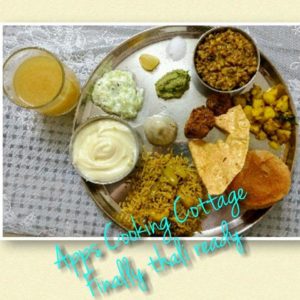
Bail Pola (बैलपोळा) :
Bail (bullock) Pola is a festival celebrated widely during monsoon season by farmers of Maharashtra. On this day farmers decorate their bulls with worship their bulls. On the day of the festival, every farmer family take their bulls to a nearby water source, massage their shoulders with turmeric paste and homemade white butter. Once massage is done, the bulls are washed from horns to tail. Then their horns and body are painted, they are adorned with ornaments, head gears, beautiful jhalars (embroidered cloth) post which woman apply kumkum and worship the bulls. A small procession is carried out by the villagers with the bulls, followed by playing lehjim (a local art form).
Its a beautiful expression of the the bond between a farmer and his cattle who considered a part of family.
On this day are traditional Maharashtrian delicacies like Puranpoli, Karanji, Khichadi, and Bhakri are cooked.
I normally am able to witness the processions done every year.
As I end the write-up on one of my favorites months of the year, I can’t help but remember one of the first songs I was taught by my singing teacher . It is sung by Suman Kalyanpur.
” दारी पाऊस पडतो, रानी पारवा भिजतो
आला आला ग, सुगंध मातीचा
बघ पागोळ्या गळती थेंब अंगणी नाचती
आला आला ग, सुगंध मातीचा
श्रावणात सारे जीव झाले बाई ओले
ऊन हळदीचे पानापानातुन खेळे
उभी पिके हिंडोलती, बाळे झाडांची बोलती
आला आला ग, सुगंध मातीचा
वसुंधरा आज नवरसात बुडाली
माळ बगळ्यांची बघ आकाशी उडाली
श्रियाळराजाचा सण चांगुणा मातेचा
नागपंचमीचा देव तो ग शोभला
कुणी गौरी ग पुजिती, गोफ रेशमी विणती
आला आला ग, सुगंध मातीचा “
